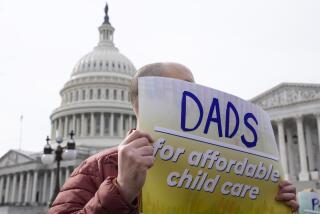Child-Care Needs Dash Dreams of Leaving Welfare
WASHINGTON — For Angie Sanches, Coterius Torrence and Wanda Sanchez, the situation is a puzzle: The government wants them to get off welfare and go to work, which they are ready and able to do. But it would apparently rather keep mailing them welfare checks than help with the child care they need if they are to hold jobs.
Sanches was so determined to get into the work force and off welfare that when she failed to find a job in her hometown in Ohio, she packed up and moved to Bloomington, Minn., where opportunities were better. Sure enough, she landed a good job.
But when she asked for subsidized day care for her 3-year-old daughter, state officials told her that the only way she could get help in less than 18 months was to go back on welfare.
Nine hundred miles to the southeast, in Atlanta, Torrence says she agrees with her caseworker that she should return to high school and work part time, but because of a shortage of state funds for child care, she cannot find affordable care for the younger of her two daughters.
In Boston, Sanchez, a single mother of four who has been on welfare for eight years, wants to return to the $8-an-hour position at an elementary school that she had to leave last spring because of child-care problems. The catch is that her caseworkers say she does not qualify for child-care subsidies because the job is part time.
“I want to be on my two feet. I don’t want to be on welfare and stay there,” said Sanchez, 28. “How do they expect me to go to work if I don’t have no day care for my kids? If I had to pay for it myself, I can’t afford it. They’re too young to be left alone. I’m not that kind of person. I’m a responsible parent.”
The vision of a new welfare system that moves poor parents into jobs instead of continuing to subsidize long-term dependence with unending cash assistance is tremendously popular with taxpayers and welfare recipients alike.
But for many recipients--and for beleaguered local officials too--the dream of “ending welfare as we know it” often founders on the rock of child-care dilemmas like these three. And what to do about funding day care will be one of the hottest issues on the table now that the Senate has returned from its August recess and begins final debate on revising welfare.
The pending GOP plan, which is endorsed by Senate Majority Leader Bob Dole (R-Kan.) and most Republican senators, would lump federal child-care dollars together with funds for cash benefits and pay them out in block grants to states, which would have the power to decide how much to allocate for child care.
Federal funding would be frozen at 1994 levels, when the government provided about $2 billion for child care for welfare recipients and the working poor.
The problem with this, Democrats and some moderate Republicans argue, is that with budget constraints holding down the overall level of federal aid, the block grants would not be large enough to cover all the needs, especially as new rules require more recipients to take jobs.
The result could be a “home alone” situation, critics say: If states are unable or unwilling to make up the difference, welfare recipients could be forced to leave their children without adequate supervision while they work.
Trying to avoid a deadlock over the issue, Dole modified the GOP plan at the end of the last congressional session to give states an option of exempting mothers with children younger than 1 from work requirements. That would ease states’ child-care needs, but some moderate Republicans and Democrats fear it would not be enough.
Nationwide, funding for the two child-care programs for welfare recipients and those moving off welfare more than doubled from 1991 to 1994, as states started to prod welfare recipients into the work force.
The increase has been still more dramatic in states that have placed a priority on funding child care. In New Jersey, for instance, child-care funding rose from $6 million to $33 million in the last several years. In Wisconsin, which has made more progress than almost any state in reforming its welfare system and decreasing its welfare rolls, child-care costs have soared from $12 million to $55 million since the state started experimenting with reform.
“Congress is being confronted with a real economic problem: Child care is so expensive we can’t afford it,” said Michelle Odom, child-care specialist for the American Public Welfare Assn., which represents welfare directors in all 50 states.
“If you don’t provide child care, people cannot go to work,” said Jackie Cheney, a deputy administrator in charge of child care in Nevada. “We talk about it here in the welfare division every day.”
While most states are delaying policy decisions until the Senate acts, some, including Vermont, have decided to reduce cash welfare benefits so they can make more money available for child care for welfare recipients who are in job training or moving into jobs.
In Delaware, state officials are counting on a boost in child-care funding in 1996 to aid parents participating in training or taking jobs under the state’s newly reformed welfare program. If the GOP plan is enacted and funds are frozen at 1994 levels, “it will not only slow it down but cripple it,” said Gloria Upshur, deputy director of the Delaware social services division.
Conservatives argue that care can be provided more cheaply in the future if old “big government” ways of thinking are changed.
“Government-operated child care is very expensive,” said Douglas Besharov, a welfare specialist at the conservative American Enterprise Institute.
There are, however, less expensive alternatives that are already being used in many places, such as having welfare recipients care for each other’s children. The number of children in unregulated day-care settings has grown steadily in recent years, experts say, though along with economic savings has come concern about the safety of some of these children.
Beyond such concerns, in the view of many of the state and local officials closest to the problem, new thinking and ingenuity can do only so much.
“Frozen federal funds means less people will be working,” said Dee Woodward, who directs Georgia’s subsidized child-care programs. “State legislatures are not going to be able to afford to purchase child care for everyone who needs it. They’re talking about cutting everything.”
Many states, including Georgia, have shifted money that was intended to help working poor families and used it for welfare recipients. There are now 20,000 working poor families on a waiting list to get child care in Georgia. In fact, most states have waiting lists.
Sanches is one of those considering a return to welfare even though she has a job.
“My cousins are baby-sitting now, but they have to go back to school,” Sanches said. “If I only make $1,400 a month--that’s $1,000 after taxes--with day care costing at least $500 and rent at least $500 I won’t have any money left at all” for food, clothes, medical costs or other expenses.
“If I don’t get child care, I’ve got to go home and get on welfare again. But I don’t want welfare. Welfare is a way to keep you from getting what you want from life. I moved to Minnesota to get off welfare. But I need some help. Child care is where they should be helping me.”
Sanches’ sentiments are echoed by others.
After living separately for almost two years in Los Angeles so they could qualify for food stamps and government-funded baby food, Michelle Redenti and her husband moved to Minneapolis, where they hoped they could finally live together as a family.
But when they moved from one suburb to another for cheaper rent, they lost their subsidized child care and were told they would have to wait 12 months or more to qualify again.
The only solution was to send their 3-year-old daughter to Redenti’s mother’s house--a five-hour drive away.
Like Redenti, Sanchez professes a strong desire to work.
“I like working,” Sanchez, 25, said. “It’s better than staying home and doing nothing, and my kids see that I’m doing something every day, which helps them go to school every day. They’ll see me as a role model--that’s what I want them to see me as.”
Though she has four children under the age of 8, she got a job last winter at a local elementary school. Her baby-sitter proved undependable, so she had to stop, but the school wants her back this fall.
Unfortunately, the school can only offer her 19 hours of work a week, just under the minimum needed for her to qualify for day-care subsidies.
As the opening day of school draws near, Sanchez is scrambling to arrange care. If she fails, she will be back on welfare.
Torrence says she wants to go back to school herself.
A 19-year-old dropout with two children, she says she knows she must finish high school to be able to support her family.
Her welfare caseworker wants her to keep her part-time job at a fast-food restaurant. Torrence’s older child was accepted in a pre-kindergarten class, which is free, but she cannot find subsidized care for her 2-year-old.
Her younger sister watches the little girls now, but she goes back to school today.
“I don’t really understand,” Torrence said recently. “They want you to do something with your life. It’s mandatory. Then they put you on a waiting list and say they don’t have enough funds. I’d be upset about it. But what can you do?”
More to Read
Sign up for Essential California
The most important California stories and recommendations in your inbox every morning.
You may occasionally receive promotional content from the Los Angeles Times.









